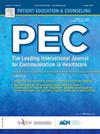Identifying, communicating, and de-escalating risk in high-stakes settings: How conversation analysis research can underpin communication training
IF 3.1
2区 医学
Q2 PUBLIC, ENVIRONMENTAL & OCCUPATIONAL HEALTH
引用次数: 0
Abstract
Objective
Communicating risk in high-stakes settings can prevent avoidable deaths. Communicating, assessing and managing risk is a critical part of many healthcare and related professionals’ roles. However, there is a dearth of empirical research on risk communication in practice. Training is seldom based on empirical evidence, meaning professionals communicating in some of the most urgent circumstances may have little formal knowledge of how to communicate about risk in practice. Focusing on high-stakes settings, we describe three projects involving work with diverse professionals to improve how they communicate to identify, mitigate, and manage risk. We integrate insights for others considering similar projects.
Methods
We present three projects where communication training about current or future threat to life in high-stakes settings was developed based on conversation analysis (CA) and its findings. Projects focused on (1) communicating the risks of emergency medical evacuation during infectious disease outbreaks (2) risk communication about suicidality and self-harm (3) crisis negotiation in the context of suicide threats
Results
In each project, researchers collaborated with practitioners to understand communication about risk moment-by-moment. They used CA to identify key challenges and develop empirical evidence of (in)effective communication practices. The evidence was used to develop resources for practitioner training. Integrated insights showed that: training is well received, core risk communication practices were often absent from extant training; collaboration with partners is crucial; and resources/funding constraints limited formal evaluation.
Conclusion
Conversation analytic research can generate insights on how risk is assessed and managed moment-by-moment in practice. These insights can underpin training based on evidence from real communication.
Practice implications
Developing training from empirical CA can equip professionals working in urgent and high-stakes circumstances to meet and address challenges in practice. Future work is likely to include systematic evaluation of the impact on interactions and patient outcomes.
在高风险环境中识别、沟通和降低风险:对话分析研究如何支持沟通培训
目的在高风险环境中传达风险信息可以预防可避免的死亡。沟通、评估和管理风险是许多医疗保健和相关专业人员角色的关键部分。然而,在实践中对风险沟通的实证研究还很缺乏。培训很少基于经验证据,这意味着在某些最紧急情况下进行沟通的专业人员可能对如何在实践中沟通风险缺乏正式知识。关注高风险环境,我们描述了三个项目,涉及与不同专业人员的工作,以改进他们如何沟通以识别、减轻和管理风险。我们为考虑类似项目的其他人整合见解。方法我们提出了三个项目,在这些项目中,基于对话分析(CA)及其发现,开发了关于高风险环境中当前或未来生命威胁的沟通培训。项目重点关注(1)传染病暴发期间紧急医疗后送风险沟通(2)自杀和自残风险沟通(3)自杀威胁背景下的危机谈判。结果在每个项目中,研究人员与从业人员合作,了解风险沟通的每个时刻。他们使用CA来识别关键挑战,并开发有效沟通实践的经验证据。这些证据被用于开发从业者培训资源。综合分析表明:培训效果良好,但现有培训中往往缺少核心风险沟通实践;与伙伴合作至关重要;资源/资金的限制限制了正式的评价。结论会话分析研究可以为实践中如何评估和管理风险提供见解。这些见解可以支持基于真实交流证据的培训。实践意义从经验CA发展培训可以装备在紧急和高风险环境中工作的专业人员,以满足和解决实践中的挑战。未来的工作可能包括对相互作用和患者预后影响的系统评估。
本文章由计算机程序翻译,如有差异,请以英文原文为准。
求助全文
约1分钟内获得全文
求助全文
来源期刊

Patient Education and Counseling
医学-公共卫生、环境卫生与职业卫生
CiteScore
5.60
自引率
11.40%
发文量
384
审稿时长
46 days
期刊介绍:
Patient Education and Counseling is an interdisciplinary, international journal for patient education and health promotion researchers, managers and clinicians. The journal seeks to explore and elucidate the educational, counseling and communication models in health care. Its aim is to provide a forum for fundamental as well as applied research, and to promote the study of organizational issues involved with the delivery of patient education, counseling, health promotion services and training models in improving communication between providers and patients.
 求助内容:
求助内容: 应助结果提醒方式:
应助结果提醒方式:


